Page 487 of 620
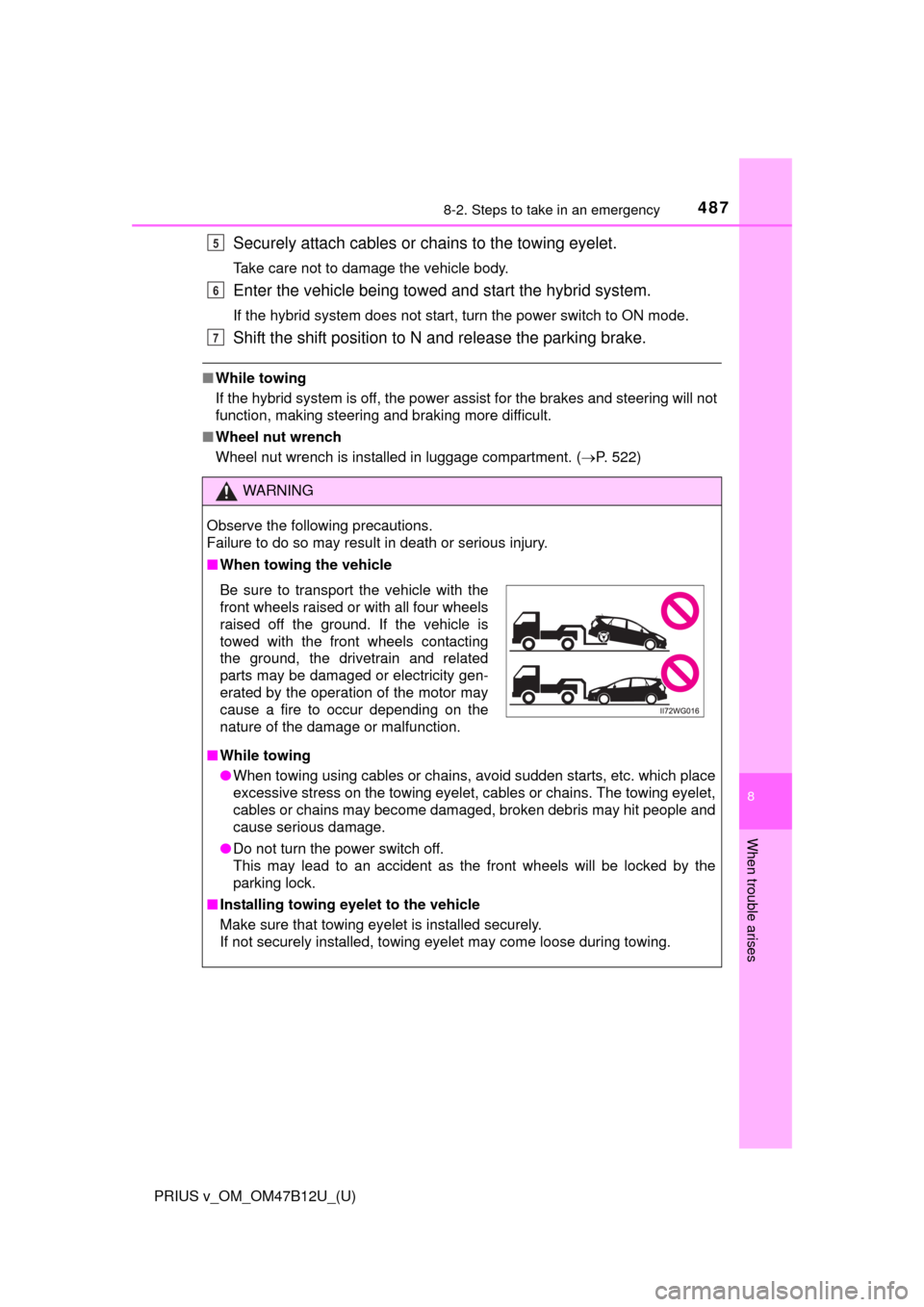
4878-2. Steps to take in an emergency
PRIUS v_OM_OM47B12U_(U)
8
When trouble arises
Securely attach cables or chains to the towing eyelet.
Take care not to damage the vehicle body.
Enter the vehicle being towed and start the hybrid system.
If the hybrid system does not start, turn the power switch to ON mode.
Shift the shift position to N and release the parking brake.
■While towing
If the hybrid system is off, the power assist for the brakes and steering will not
function, making steering and braking more difficult.
■Wheel nut wrench
Wheel nut wrench is installed in luggage compartment. (P. 522)
WARNING
Observe the following precautions.
Failure to do so may result in death or serious injury.
■When towing the vehicle
■While towing
●When towing using cables or chains, avoid sudden starts, etc. which place
excessive stress on the towing eyelet, cables or chains. The towing eyelet,
cables or chains may become damaged, broken debris may hit people and
cause serious damage.
●Do not turn the power switch off.
This may lead to an accident as the front wheels will be locked by the
parking lock.
■Installing towing eyelet to the vehicle
Make sure that towing eyelet is installed securely.
If not securely installed, towing eyelet may come loose during towing.
5
6
7
Be sure to transport the vehicle with the
front wheels raised or with all four wheels
raised off the ground. If the vehicle is
towed with the front wheels contacting
the ground, the drivetrain and related
parts may be damaged or electricity gen-
erated by the operation of the motor may
cause a fire to occur depending on the
nature of the damage or malfunction.
Page 498 of 620
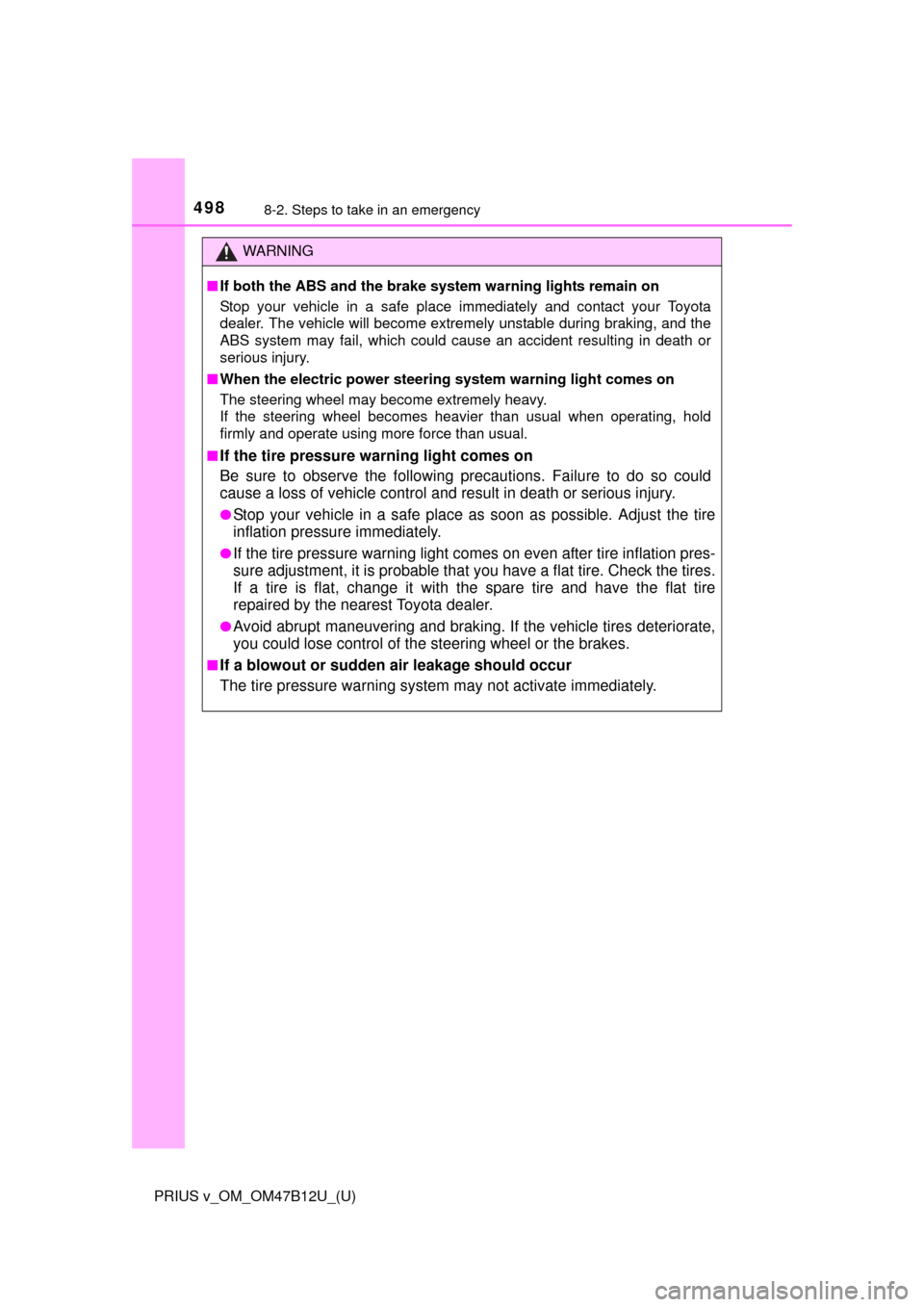
4988-2. Steps to take in an emergency
PRIUS v_OM_OM47B12U_(U)
WARNING
■If both the ABS and the brake system warning lights remain on
Stop your vehicle in a safe place immediately and contact your Toyota
dealer. The vehicle will become extremely unstable during braking, and the
ABS system may fail, which could cause an accident resulting in death or
serious injury.
■When the electric power steering system warning light comes on
The steering wheel may become extremely heavy.
If the steering wheel becomes heavier than usual when operating, hold
firmly and operate using more force than usual.
■
If the tire pressure warning light comes on
Be sure to observe the following precautions. Failure to do so could
cause a loss of vehicle control and result in death or serious injury.
●Stop your vehicle in a safe place as soon as possible. Adjust the tire
inflation pressure immediately.
●If the tire pressure warning light comes on even after tire inflation pres-
sure adjustment, it is probable that you have a flat tire. Check the tires.
If a tire is flat, change it with the spare tire and have the flat tire
repaired by the nearest Toyota dealer.
●Avoid abrupt maneuvering and braking. If the vehicle tires deteriorate,
you could lose control of the steering wheel or the brakes.
■If a blowout or sudden air leakage should occur
The tire pressure warning system may not activate immediately.
Page 504 of 620
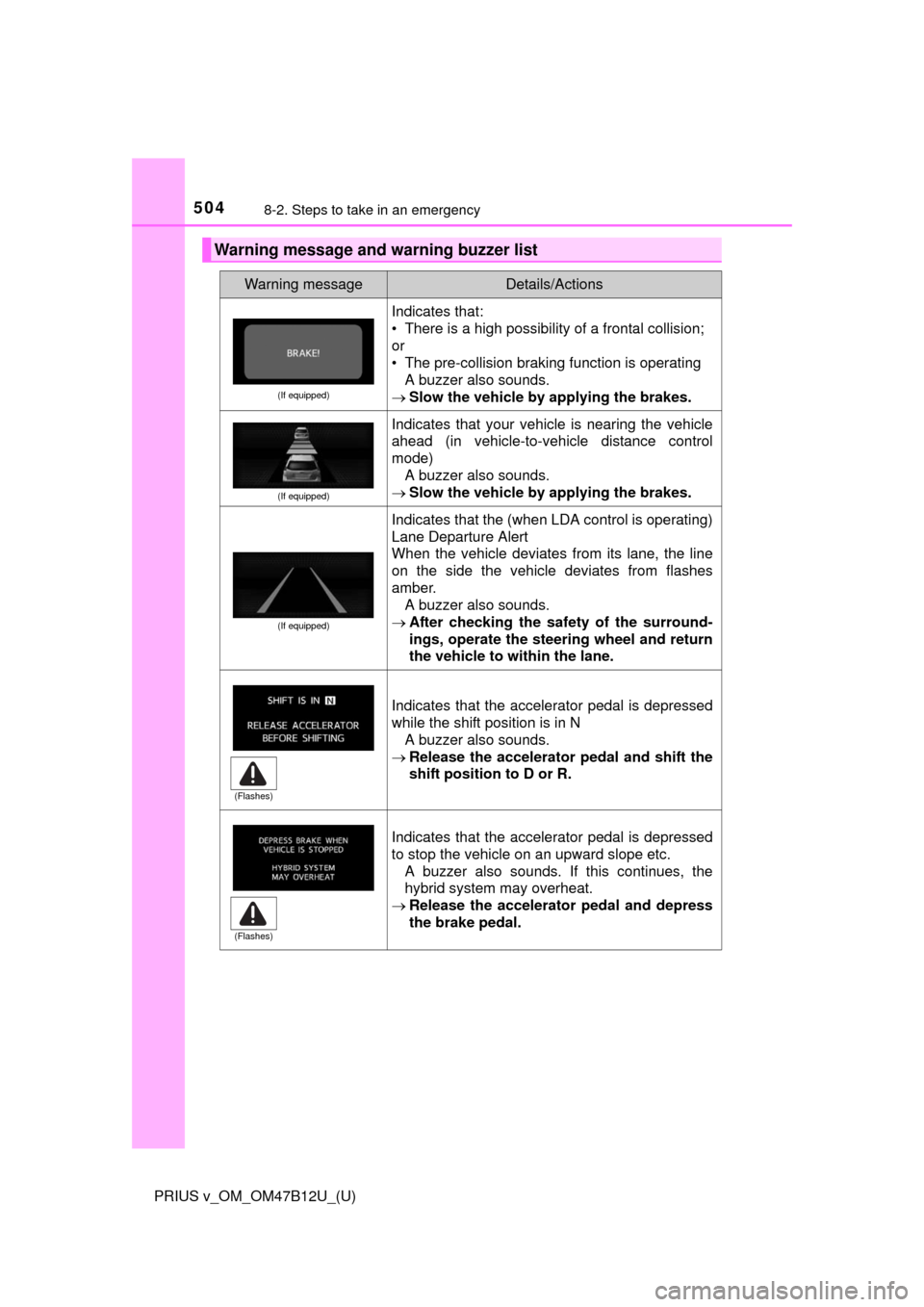
5048-2. Steps to take in an emergency
PRIUS v_OM_OM47B12U_(U)
Warning message and warning buzzer list
Warning messageDetails/Actions
(If equipped)
Indicates that:
• There is a high possibility of a frontal collision;
or
• The pre-collision braking function is operating
A buzzer also sounds.
Slow the vehicle by applying the brakes.
(If equipped)
Indicates that your vehicle is nearing the vehicle
ahead (in vehicle-to-vehicle distance control
mode)
A buzzer also sounds.
Slow the vehicle by applying the brakes.
(If equipped)
Indicates that the (when LDA control is operating)
Lane Departure Alert
When the vehicle deviates from its lane, the line
on the side the vehicle deviates from flashes
amber.
A buzzer also sounds.
After checking the safety of the surround-
ings, operate the steering wheel and return
the vehicle to within the lane.
Indicates that the accelerator pedal is depressed
while the shift position is in N
A buzzer also sounds.
Release the accelerator pedal and shift the
shift position to D or R.
Indicates that the accelerator pedal is depressed
to stop the vehicle on an upward slope etc.
A buzzer also sounds. If this continues, the
hybrid system may overheat.
Release the accelerator pedal and depress
the brake pedal.
(Flashes)
(Flashes)
Page 528 of 620

5288-2. Steps to take in an emergency
PRIUS v_OM_OM47B12U_(U)
WARNING
■Replacing a flat tire
●Do not touch the disc wheels or the area around the brakes immedi-
ately after the vehicle has been driven.
After the vehicle has been driven the disc wheels and the area around
the brakes will be extremely hot. Touching these areas with hands, feet
or other body parts while changing a tire, etc. may result in burns.
●Failure to follow these precautions could cause the wheel nuts to
loosen and the tire to fall off, resulting in death or serious injury.
• Have the wheel nuts tightened with a torque wrench to 76 ft•lbf (103
N•m, 10.5 kgf•m) as soon as possible after changing wheels.
• When installing a tire, only use wheel nuts that have been specifi-
cally designed for that wheel.
• If there are any cracks or deformations in the bolt screws, nut
threads or bolt holes of the wheel, have the vehicle inspected by
your Toyota dealer.
• When installing the wheel nuts, be sure to install the wheel nuts with
the tapered ends facing inward. (P. 456)
Page 558 of 620

558
PRIUS v_OM_OM47B12U_(U)
9-1. Specifications
*: The fluid capacity is the quantity of reference.
If replacement is necessary, contact your Toyota dealer.
*1: Minimum pedal clearance when depressed with a force of 44.1 lbf (196 N,
20.0 kgf) while the hybrid system is operating.
*2: Parking brake pedal travel when depressed with a force of 67.5 lbf (300 N,
30.6 kgf).
Transmission
Fluid capacity*3.6 qt. (3.4 L, 3.0 Imp.qt.)
Fluid typeToyota Genuine ATF WS
NOTICE
■Transmission fluid type
Using transmission fluid other than “Toyota Genuine ATF WS” may cause
deterioration in shift quality, locking up of your transmission accompanied
by vibration, and ultimately damage the transmission of your vehicle.
Brakes
Pedal clearance*12.95 in. (75 mm) Min.
Pedal free play0.04 — 0.24 in. (1.0 — 6.0 mm)
Brake pad wear limit0.04 in. (1.0 mm)
Parking brake lining wear
limit0.04 in. (1.0 mm)
Parking brake pedal travel*28 —11 clicks
Fluid typeFMVSS No. 116 DOT 3 or SAE J1703
Steering
Free playLess than 1.2 in. (30 mm)
Page 569 of 620
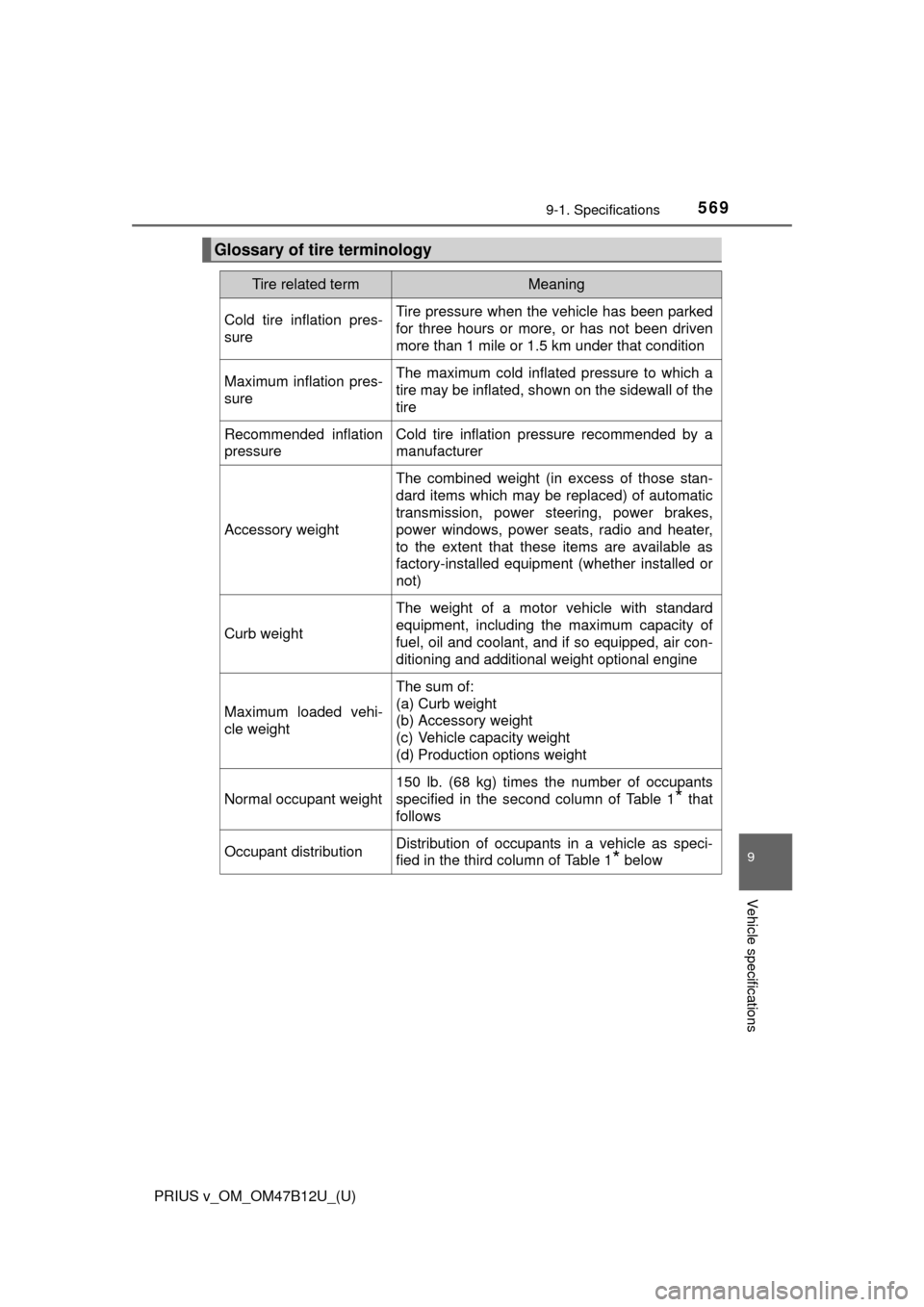
PRIUS v_OM_OM47B12U_(U)
5699-1. Specifications
9
Vehicle specifications
Glossary of tire terminology
Tire related termMeaning
Cold tire inflation pres-
sureTire pressure when the vehicle has been parked
for three hours or more, or has not been driven
more than 1 mile or 1.5 km under that condition
Maximum inflation pres-
sureThe maximum cold inflated pressure to which a
tire may be inflated, shown on the sidewall of the
tire
Recommended inflation
pressureCold tire inflation pressure recommended by a
manufacturer
Accessory weight
The combined weight (in excess of those stan-
dard items which may be replaced) of automatic
transmission, power steering, power brakes,
power windows, power seats, radio and heater,
to the extent that these items are available as
factory-installed equipment (whether installed or
not)
Curb weight
The weight of a motor vehicle with standard
equipment, including the maximum capacity of
fuel, oil and coolant, and if so equipped, air con-
ditioning and additional weight optional engine
Maximum loaded vehi-
cle weight
The sum of:
(a) Curb weight
(b) Accessory weight
(c) Vehicle capacity weight
(d) Production options weight
Normal occupant weight
150 lb. (68 kg) times the number of occupants
specified in the second column of Table 1
* that
follows
Occupant distributionDistribution of occupants in a vehicle as speci-
fied in the third column of Table 1
* below
Page 570 of 620
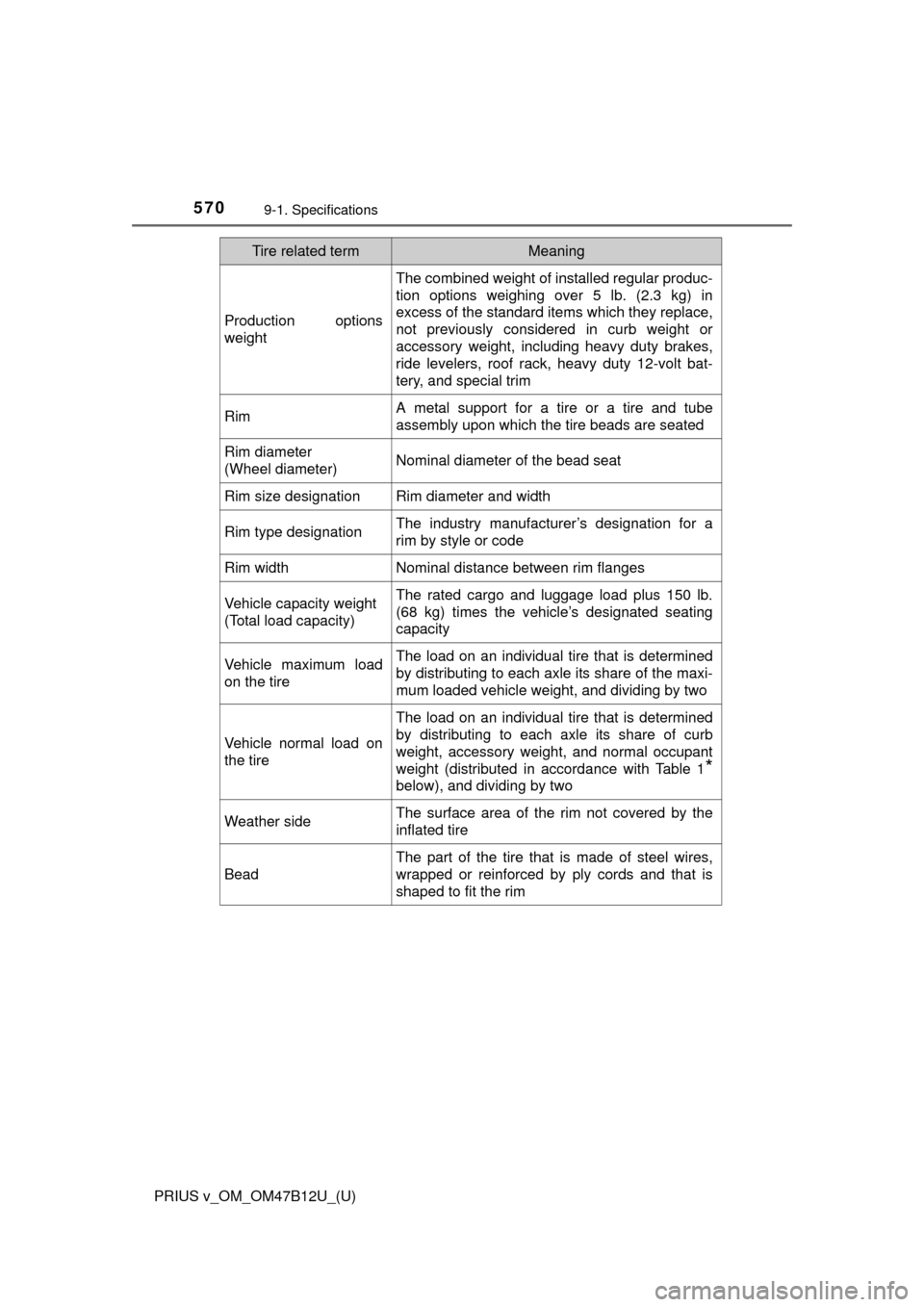
570
PRIUS v_OM_OM47B12U_(U)
9-1. Specifications
Production options
weight
The combined weight of installed regular produc-
tion options weighing over 5 lb. (2.3 kg) in
excess of the standard items which they replace,
not previously considered in curb weight or
accessory weight, including heavy duty brakes,
ride levelers, roof rack, heavy duty 12-volt bat-
tery, and special trim
RimA metal support for a tire or a tire and tube
assembly upon which the tire beads are seated
Rim diameter
(Wheel diameter)Nominal diameter of the bead seat
Rim size designationRim diameter and width
Rim type designationThe industry manufacturer’s designation for a
rim by style or code
Rim widthNominal distance between rim flanges
Vehicle capacity weight
(Total load capacity)The rated cargo and luggage load plus 150 lb.
(68 kg) times the vehicle’s designated seating
capacity
Vehicle maximum load
on the tireThe load on an individual tire that is determined
by distributing to each axle its share of the maxi-
mum loaded vehicle weight, and dividing by two
Vehicle normal load on
the tire
The load on an individual tire that is determined
by distributing to each axle its share of curb
weight, accessory weight, and normal occupant
weight (distributed in accordance with Table 1
*
below), and dividing by two
Weather sideThe surface area of the rim not covered by the
inflated tire
Bead
The part of the tire that is made of steel wires,
wrapped or reinforced by ply cords and that is
shaped to fit the rim
Tire related termMeaning
Page:
< prev 1-8 9-16 17-24